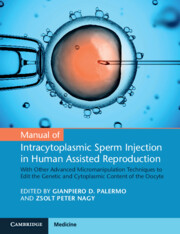 Manual of Intracytoplasmic Sperm Injection in Human Assisted Reproduction
Manual of Intracytoplasmic Sperm Injection in Human Assisted Reproduction Book contents
- Manual of Intracytoplasmic Sperm Injection in Human Assisted Reproduction
- Manual of Intracytoplasmic Sperm Injection in Human Assisted Reproduction
- Copyright page
- Contents
- Contributors
- Foreword
- Chapter 1 In Vitro Fertilization and Micromanipulation
- Chapter 2 Development of ICSI in Human Assisted Reproduction
- Chapter 3 Current ICSI Applications and Clinical Outcomes
- Chapter 4 Rescue ICSI of IVF Failed-Fertilized Oocytes
- Chapter 5 Morphological Sperm Selection Before ICSI
- Chapter 6 Laser-Assisted ICSI
- Chapter 7 Piezo: The Add-On to Standardize ICSI Procedure
- Chapter 8 Artificial Oocyte Activation After ICSI
- Chapter 9 Health of Children Born after Intracytoplasmic Sperm Injections (ICSI)
- Chapter 10 Examining the Safety of ICSI Using Animal Models
- Chapter 11 Cellular and Molecular Events after ICSI in Clinically Relevant Animal Models
- Chapter 12 Micromanipulation, Micro-Injection Microscopes and Systems for ICSI
- Chapter 13 Automation Techniques and Systems for ICSI
- Chapter 14 Germline Nuclear Transfer Technology to Overcome Mitochondrial Diseases and Female Infertility
- Chapter 15 Nuclear Transfer Technology and Its Use in Reproductive Medicine
- Chapter 16 The Prospects of Infertility Treatment Using “Artificial” Eggs
- Index
- Plate Section (PDF Only)
- References
Chapter 13 - Automation Techniques and Systems for ICSI
Published online by Cambridge University Press: 02 December 2021
- Manual of Intracytoplasmic Sperm Injection in Human Assisted Reproduction
- Manual of Intracytoplasmic Sperm Injection in Human Assisted Reproduction
- Copyright page
- Contents
- Contributors
- Foreword
- Chapter 1 In Vitro Fertilization and Micromanipulation
- Chapter 2 Development of ICSI in Human Assisted Reproduction
- Chapter 3 Current ICSI Applications and Clinical Outcomes
- Chapter 4 Rescue ICSI of IVF Failed-Fertilized Oocytes
- Chapter 5 Morphological Sperm Selection Before ICSI
- Chapter 6 Laser-Assisted ICSI
- Chapter 7 Piezo: The Add-On to Standardize ICSI Procedure
- Chapter 8 Artificial Oocyte Activation After ICSI
- Chapter 9 Health of Children Born after Intracytoplasmic Sperm Injections (ICSI)
- Chapter 10 Examining the Safety of ICSI Using Animal Models
- Chapter 11 Cellular and Molecular Events after ICSI in Clinically Relevant Animal Models
- Chapter 12 Micromanipulation, Micro-Injection Microscopes and Systems for ICSI
- Chapter 13 Automation Techniques and Systems for ICSI
- Chapter 14 Germline Nuclear Transfer Technology to Overcome Mitochondrial Diseases and Female Infertility
- Chapter 15 Nuclear Transfer Technology and Its Use in Reproductive Medicine
- Chapter 16 The Prospects of Infertility Treatment Using “Artificial” Eggs
- Index
- Plate Section (PDF Only)
- References
Summary
This chapter introduces automation techniques for intracytoplasmic sperm injection (ICSI). These techniques are used for sperm motility and morphology quantification, sperm immobilization, sperm aspiration, oocyte orientation control, and sperm injection. Emerging techniques are also described such as computer assisted sperm analysis, laser immobilization, deep learning based polar body detection, and piezo drilling for reducing cell deformation in penetration. Finally, outlooks for future development of automation techniques in ICSI are provided.
- Type
- Chapter
- Information
- Manual of Intracytoplasmic Sperm Injection in Human Assisted ReproductionWith Other Advanced Micromanipulation Techniques to Edit the Genetic and Cytoplasmic Content of the Oocyte, pp. 129 - 140Publisher: Cambridge University PressPrint publication year: 2021
References
- 1
- Cited by


